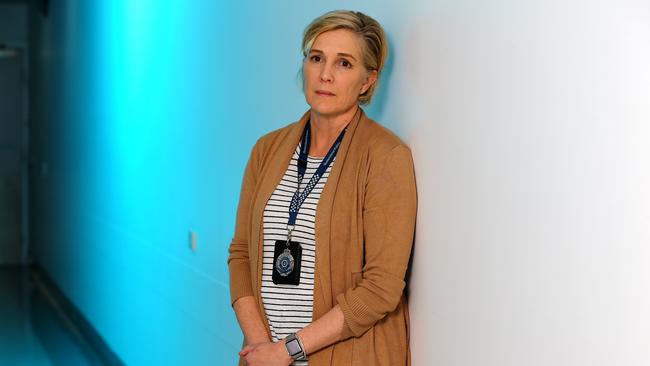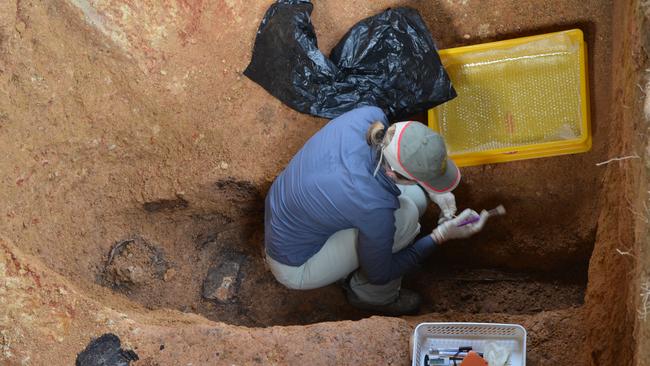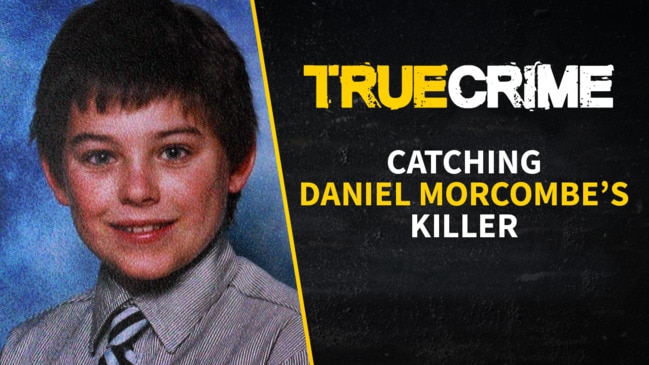Body in the wall, burning torso: Inside the world of Qld’s ‘Bone Lady’
From a sombre find in an unmarked battlefield burial ground in France to a breakthrough discovery in a Sunshine Coast macadamia farm, this is the remarkable story of Queensland’s ‘bone lady’.

News
Don't miss out on the headlines from News. Followed categories will be added to My News.
Nearly 100 years after thousands of Australian soldiers died in the mud of Mouquet Farm, a Queensland police officer on loan to the Australian Army settled in to dig for bones.
Over several weeks in 1916, Australian soldiers stationed in the north of France fought to take the farm from German forces, digging trenches into sodden earth as howitzer shells blew them up.
More than 11,000 Australian soldiers died there. Many remain there still.
And in 2014, farm workers digging trenches for irrigation along the chequerboard fields unearthed the skeletal remains of an unknown Australian soldier.
“It was one of my first trips ever with the Army over to Europe,” says Senior Sergeant Donna MacGregor, forensic anthropologist and officer in charge of the Queensland Police Service’s major crime scientific unit.
“I work for a unit called Unrecovered War Casualties Team and our brief is to find
and account for our missing soldiers from
past conflicts.
“We were there because someone had reported … they were putting down an irrigation trench at Mouquet Farm and they’d located some remains.”

MacGregor was part of the team sent to France to recover and repatriate the soldier, identified as Australian by the remnants of
his uniform.
“We found a skeleton,” MacGregor recalls. He still had his Australian flash and infantry badge on his left shoulder.
“This was really sombre for me and the team because it’s one of the few times I’ve ever seen the flash in situ on the shoulder.
“He had his belt, his weaponry and everything on him too but to see that on his shoulder with that little piece of cloth patch still there, you’re thinking, he’s one of ours, he’s a Digger, he’s an ANZAC.”
But sombre soon turned to incredulity. The team was approached and informed they’d been given the wrong coordinates. They were digging in the wrong spot – but had found a missing Australian soldier anyway. A different soldier to the one they’d been sent to bring home.
“In those areas, we have tens of thousands of men still missing and it’s not going to
be unusual (to find human remains),” MacGregor says.
“Mouquet Farm is where the Australians first joined the Western Front after they came off the peninsula at Gallipoli.”
The accidentally discovered soldier was exhumed and examined.

Samples were taken and a DNA profile obtained in the hope that it will one day lead
to him recovering his name, his identity, his family.
After, he was buried with ceremony at the Pozieres British Cemetery on July 22, 2016 – on the eve of the 100th anniversary of the start of the Battle of Pozieres. An unknown soldier who lay deep in the dirt, among the wheat and the silverbeet, for a century.
HOW THE ‘BONE LADY’ BEGAN
Senior Sergeant Donna MacGregor entered the police academy in 2000. She was 27 years old and already well entrenched in the world of science. She had a postgraduate degree, was working on her thesis and teaching as a sessional academic.
For three years she worked as a general duties officer between the city and Indooroopilly before joining the scientific section.
Her job was to examine the scenes of major crimes.
Fire, suspicious deaths, sexual assaults.

In 2010, she left the police to work at QUT as a lecturer in anatomy. But law enforcement would draw her back and after two years, she returned to the police part-time while also teaching and conducting research in anthropology.
“I could come back for days at a time if we had to go and do a cold case dig with homicide or similar – but we’d organise those in advance for when it was a semester break,” MacGregor says.
Then, in 2022, she returned to the QPS full time, first as a forensic scientist and then as a senior coronial officer in the police coronial support unit.
And this year, she took on a new role as the officer in charge of the Major Crime Scientific Unit.
SOLVING PUZZLES, FINDING ANSWERS
MacGregor sits in the courtyard outside her office at Queensland Health’s Forensic and Scientific Services.
It’s in these buildings that events picked over by the Commission of Inquiry into Forensic DNA Testing in Queensland occurred, where staff were grilled over the decision to stop testing samples under a certain threshold and instead label them as having “no DNA” – potentially compromising thousands of criminal investigations.
But MacGregor’s job here (until recently) was with the dead. Solving puzzles. Finding answers.
In her role as a senior coronial officer, she was responsible for processing “natural” and “reportable” deaths.
“There are lots of different ways that death can occur,” MacGregor says. Homicide. Suicide. A car crash. A fall, drowning, electrocution. A death in custody. A death where the person’s identity is not known.

The bodies are driven here in white vans, through to a roller door where they are taken into the mortuary. They are in sealed body bags to protect evidence and not opened unless an internal autopsy is required.
Only 15 to 20 per cent will require an internal autopsy. For most, a CT scan will provide the forensic pathologists with enough information to determine what has happened.
“We work with Queensland Health, who have nurses, pathologists, counsellors and who have great admin staff, the whole mortuary team, including the morgue techs, the radiographers and odontologists,” MacGregor says.
“So we, the police team, are working with all those people in that space to facilitate the coronial process.
“The police team is at the front end processing all the paperwork to make sure the matter is correctly managed and or reported.
“We have to decide whether it’s reportable or a natural death.”
THE MOMENT WE FOUND DANIEL MORCOMBE
It was August 2011 and MacGregor, on extended leave without pay from the police service, got a call for help.
Deep in the Glasshouse Mountains, at a macadamia farm, the search was on to find the body of a 13-year-old boy who had disappeared from the side of the road eight years earlier.
Daniel Morcombe had been lured from a bus stop by serial predator Brett Peter Cowan, who police had arrested after a lengthy and complex covert operation.
Cowan, believing he had been recruited by an organised crime group, had confessed to abducting and murdering the teen and hiding his body down an embankment at a Sunshine Coast property.
He’d drawn them a map and even flown from Perth to Brisbane to take his new-found “friends” to the place where he’d left Daniel.
But police were now left with the problem of whether they’d be able to find him after eight years and two major flooding events – including one earlier that year that had left more than 30 people dead.

They called in experts of every kind. Hydrologists, zoologists, a fluvial geomorphologist. They brought in excavators and State Emergency Services volunteers and police recruits in their droves.
Then they got down in the mud and the muck, pushed through lantana, and sifted through dirt.
It took five days to make the first discovery.
A shoe. Weathered and rotting, poking through soil.
That’s when they knew they’d find Daniel. That’s when they called MacGregor. “My job is not to investigate or prosecute,” she says.
“That’s the role of the detectives. My job is, if he’s there, we’ll find him, and we can give him back to his family and they can bury their son.”
“So yes, we as forensics help the detectives. But an essential part of our work in forensics is to help bring closure to the families – while the detectives are another whole specialty. I trust them to do their job, and my job is simply, if they’re here, we’ll find them.”
She arrived on the day search teams found the second shoe.

“There’s ways to search and ways to search and there were a lot of people on site,” MacGregor says.
She convened with Inspector Arthur “Arty” Van Panhuis, the then-forensic co-ordinator for the Sunshine Coast.
“Arty was fantastic. He said ‘what do you think, can we do this?’ – and we just changed
the search parameters on that first day and we were bang on. We found the first bone,” MacGregor says.
It was part luck, part management and part analysis of the terrain.
Based on Cowan’s confession, they’d been focusing on an area around a dam.

“When you looked at that site, it was interesting because it had an escarpment all the way around it and a low area and the dam.
“So ideally, it’s a contained area. It’s not a big, flat area.”
Search teams were spread out over vast areas. MacGregor and Van Panhuis brought them all back in.
“And I said, ‘can we just have one long emu line searching across the site rather than people everywhere … I think that day we had around 100 SES people on site,” she says.
“The SES are amazing. They kept turning up and helping and the hours they put in – it couldn’t have been done without them.”
THE MYSTERY OF THE BURNING TORSO
In 2013, fire crews headed out to a small fire burning on the side of Cedar Pocket Rd near Gympie.
It had been called in by passing motorists. Curiously, someone had seen a blonde woman in activewear drive away from the flames.
Firefighters arrived to find a burning human torso, separated at the abdomen and missing the head and hands.
With no way to identify the body, police brought MacGregor into their arsenal. She told them they were looking for a man, gave them an age range and told them he’d most likely done some sort of manual labour, given the state of his spine.

“You do whatever you can, you measure whatever you can,” MacGregor says.
“Anthropology is right at the front end of the process. The bread and butter of our work is the ancestry, the sex, the age and the stature – and any anomalies or pathologies or any trauma that might have contributed towards the death.
“Ancestry is usually seen by the skull. When we walk down the street and we see someone, we see their biological heritage in their face. You can’t hide it.”
They took a CT scan of the man’s body and analysed the rib ends to try to provide police with an estimate of his age.
The rib end where it meets the sternum changes as someone gets older and can be analysed to determine someone’s age – to an incredible 96 per cent accuracy.
But a CT scan, depending on its resolution, can distort that with “noise”. To be sure, MacGregor asked the Coroner for permission to remove the man’s rib end so it could be properly measured.
Beetle larvae were used to remove the flesh without damaging the bone. And soon police had their age range.
With no DNA match and no match to known missing persons reports, police had the man’s blood analysed. He’d had a particular combination of medication in his system. Detectives approached Medicare to ask for the name of every man prescribed that particular combination. There were thousands. MacGregor helped them narrow it down.
It went on for months. They thought they’d failed, until, right near the bottom of their list, they knocked on the right door.
The home belonged to 66-year-old George Gerbic, but it was his partner Lindy Williams who answered.
She told them he was overseas. Checks revealed she was lying. Williams is now serving a life sentence for Gerbic’s murder and will fall under No Body, No Parole legislation, given the rest of his body has never been found.
THE BODY IN THE WALL … WHO WAS SHE?
It took police from two law enforcement agencies (Queensland police and the AFP), scientists and experts eight months to put a name to the Jane Doe who lay hidden and unmissed in a dark alcove under a Brisbane apartment building for 15 years.
MacGregor, unsurprisingly, was one of them.
They found the woman’s body on December 7, 2022, behind a Besser brick wall in a storage area at the rear of the Alderley complex’s parking garage.
She’d been murdered, wrapped and hidden away. Nobody had reported her missing, and for months, despite public appeals by police, nobody came forward.
This time, MacGregor had a complete skeleton. It told a story. She was caucasian, 155-165cm tall. She wore size 10 clothing and prescription glasses. Her hair was dark brown.
They used her teeth for radiocarbon dating to determine her age – about 40 when she died.
Again, she matched no known missing persons cases and her DNA did not match anyone on Australian databases.

It would be meticulous genetic genealogy research that gave the woman in the wall back her name – Tanya Lee Glover.
Investigators used the woman’s DNA and available information from “family tree” websites to find distant relatives, then worked backwards.
Information from scientists like MacGregor narrowed it down, made the search achievable.
“This is a single vulnerable lady that lived a very carefree lifestyle, and for whatever reason has been targeted for an unknown purpose and dealt with in a very horrid way,” Detective Superintendent Andrew Massingham told media, as he announced the breakthrough.

Glover, originally from NSW, was living in Fortitude Valley when she vanished around 2010, aged 38. She was vision and hearing impaired and had lost contact with her interstate parents, who had not known she was missing. And now they know who she is, police must now find Glover’s killer.
“You have to understand, there’s a human face to this, there’s real people involved,” MacGregor says of her work.
MacGregor’s new job has taken her out of the morgue and back to Roma St, where
the state’s biggest crimes are analysed and hopefully solved.

She is the officer in charge of the QPS major crime forensic unit and her team is responsible for providing expert opinions to detectives about what has happened at the scene of a crime.
“So this may be blood spatter interpretation, or for shoe sole comparison, or trying to reconstruct the crime scene, or the sequence of events. That’s their job,” she says.
“They are a team of experts in crime scene examination at that really high level classed as major crime.
“They can reconstruct a fire scene to see if it’s arson.
“They can look at blood and talk about the pattern and what happened. They can look at shoe soles and who might have been there to identify the shoe (and the wearer).”
It’s a very different role but the premise is the same. She’s a puzzle solver, using decades of experience to hand investigators a piece at a time. Sometimes the puzzle piece is tiny. Sometimes it’s just the piece they needed.
Originally published as Body in the wall, burning torso: Inside the world of Qld’s ‘Bone Lady’




